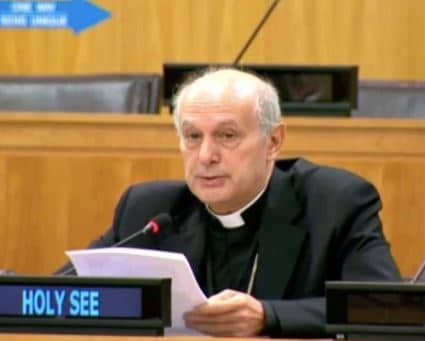The Holy See this week affirmed UN action on human trafficking.
Below are the remarks by Archbishop Gabriele Caccia, Apostolic Nuncio and Permanent Observer of the Holy See to the United Nations, at the High-Level Meeting on the Appraisal of the United Nations Global Plan of Action to Combat Trafficking in Persons, New York, November 23, 2021.
***
Mr. President,
The Holy See is pleased to participate in this High-Level Meeting on the appraisal of the United Nations Global Plan of Action to Combat Trafficking in Persons, which will help further strengthen our cooperation and coordination to prevent and combat trafficking in persons, assist victims, and prosecute those responsible for this heinous crime and grave violation of human dignity and human rights.
International cooperation and data collection
Further implementing the Global Plan of Action requires, first and foremost, an evaluation of the progress made and the remaining gaps on the four objectives that underpin it. Such assessment is particularly challenging due to the lack of reliable global estimates of the number of victims. Despite the increasing number of states that have developed national data collection systems on trafficking in persons in the past decades, world data is still limited,[1] a fact that unfortunately weakens more effective international action.
COVID-19 and certain categories of victims
The COVID-19 pandemic has made this undertaking even more complex as it has made victims more isolated and less visible, while its socio-economic consequences have exacerbated the vulnerability of those most at risk of being trafficked, including the many millions of women and men who have lost their jobs and have been left without social support.
Children, especially those from extremely poor households and those without parental care, continue to account for about one-third of trafficking victims detected, especially in the poorest countries, where trafficking is linked to the broader problem of child labor. The impact of the pandemic on school closures has further added millions of children to the ranks of those vulnerable to trafficking.
Women and girls still constitute the vast majority of victims. They are trafficked, sold, coerced or subjected to conditions of slavery in various forms and in various sectors, particularly sex trafficking.[2] Eradicating practices such as pornography and prostitution that dehumanize women and girls and reduce their bodies to mere objects of gratification is a crucial part of the fight against trafficking. Numerous data and studies have confirmed, beyond doubt, that pornography and prostitution contribute to trafficking.
Progress made and progress to build on
Despite the alarming situation and the many challenges that we face, there has been significant progress in a number of crucial areas.
First, many of the social, economic, cultural, political and other factors that make people vulnerable to human trafficking, such as poverty, conflict, forced migration, humanitarian crises, exclusion, and lack of access to education and employment opportunities, have been more clearly identified and comprehensive policies and programs to address them have been formulated.
Second, there is growing awareness and legal recognition that victims should not be inappropriately punished or prosecuted for acts they might have committed as a direct consequence of being trafficked. Many more services are in place to identify and liberate victims, regularize their situation, and put them on the path to recovery and rehabilitation.
Third, there have also been significant advances in formulating the legal norms needed to investigate, prosecute and punish traffickers, linking trafficking with other forms of organized crime and corruption, and fostering cooperation at and across borders. Every year, more traffickers are being brought to justice. Moreover, in the past decade, an increasing number of countries have criminalized trafficking in line with the Trafficking in Persons Protocol under the United Nations Convention Against Transnational Organized Crime.[3]
Finally, partnerships among States and relevant stakeholders have been strengthened. Naturally, these form the basis for a concerted work that must be always enhanced. Particularly crucial in many regions of the world is the cooperation between local authorities, national governments, and faith-based organizations. In this regard, the impressive work carried out by religious sisters, internationally, nationally, and locally – as with the Talitha Kum’s networks, present in 92 countries on six continents – has helped address the root causes of trafficking in persons, care for victims, and, in some cases, collaborate with law enforcement authorities in the fight against trafficking and other contemporary forms of modern slavery.
The Holy See will continue to play its role in preventing, denouncing and combatting this plague and in promoting a model of cooperation based on fraternity, solidarity, and commitment capable of remedying the globalization of indifference in which human trafficking thrives.
Thank you, Mr. President.
[1]Cf. UNODC, Global Report on Trafficking in Persons, 2020.
[2]Cf. Pope Francis, Encyclical Letter, Fratelli Tutti, 24.
[3]Cf. UNODC, Global Report on Trafficking in Persons, 2020.
Copyright © 2021 Permanent Observer Mission of the Holy See to the United Nations, All rights reserved.










